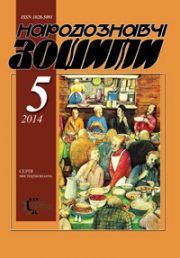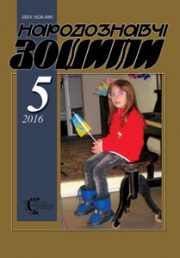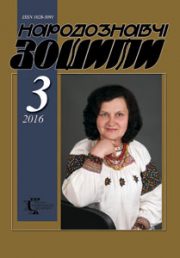The Ethnology Notebooks. 2021. # 2 (158), P. 327—341
УДК 398.33:2-545(477)”18/20″
DOI https://doi.org/10.15407/nz2021.02.327
Olena Serebryakova
- candidate of Historical Sciences,
- research worker of the department
- of the modern ethnology
- of the Ethnology Institute
- of National Academy of Sciences of Ukraine
- 15, Svobody Avenue, 79000, Lviv, Ukraine
- e-mail: o-sereb@ukr.net
Actuality of the article is due to the fact that there is still no special article paper of the peculiarities of the existence of mantic and magic actions in different regions of Ukraine during the year. They were carried out the time mainly of the twelve days between Christmas and Epiphany in order to predict the crop, favorable days for plowing, weather, health of family members and livestock, marriage. Therefore, the aim of the offered article is coverage of the layer of the custom of ritual and world-view phenomena associated with the divination and magic actions about the harvest of cereals, vegetables, fruit trees, honey, amount of bees, cows and calves etc. Among them — varieties, prophetic signs, mythological presentations, archaic elements etc.
The object of the research is the traditional world view and the custom and rite culture of the inhabitants of Ukraine, and the subject — calendar mantic and magic actions with different ritual attributes (coal, ritual foods, grains of bread, spikelets of cereal, vegetable crops etc.), which carried out to during various holidays of calendar. The basis for the article are the materials of the field research, local lore articles and works of the end of nineteenth and the beginning of the twenty-first centuries. Also comparative material from other regions of Ukraine is presented. For the best opening of originality of divination and magic actions in Ukraine use also information about them in the traditional culture of other people of the world. The methodology of this work is based on general scientific methodological principles and the basic requirements that apply to the works of historical and ethnological direction.
Mantic and magic traditions related to the ceremonial use of coals, seeds of cereals and vegetable crops of different varieties etc. in the fortunetelling and magic actions the time to during various holidays of calendar of the inhabitants of Ukraine are analyzed. Their functionality, semantics, attributive, verbal levels, functional purpose, symbolism and magical properties of ritual attributes, modifications, and also degree of preservation of investigated phenomena in modern time are revealed.
It was found out that the considered variants of calendar divination and magic actions with different ritual attributes in the Ukrainians have peculiar features. Among the remnants of archaic phenomena the cult of ancestors, belief in the truth of the results of divinations, verbal, productive magic, the magic of protection, magical properties of ritual attributes and their use in various mantic and magic actions etc. was preserved.
Keywords: mantic and magic actions/practices/customs (divination), calendar holidays, Ukrainians, coals, ritual wheat porridge, bread, cinder, crop.
REFERENCES
- Schnaider, J. (1899). From the land of the Hutsuls (Hutsul calendar). Lud, III (Vol. V, pp. 207—220). Lwow [in Polish].
- Archive of the IN NANU (Archive of the Institute of Ethnology of the National Academy of Sciences of Ukraine). F. 1. Op. 2. Od. save 513 [in Ukrainian].
- Archive of the IN NANU. F. 1. Op. 2. Od. save 659 [in Ukrainian].
- Archive of the IN NANU. F. 1. Op. 2. Od. save 655 [in Ukrainian].
- Archive of the IN NANU. F. 1. Op. 2. Od. save 702 [in Ukrainian].
- Archive of the IN NANU. F. 1. Op. 2. Od. save 691 [in Ukrainian].
- Falkowski, J. (1937). Western border of Hutsul land. Lwow [in Polish].
- Shukhevych, V.O. (1999). Hutsul land (Part 4).Verkhovyna: Hutsul’schyna [in Ukrainian].
- Archive of the IN NANU. F. 1. Op. 2. Od. save 658 [in Ukrainian].
- Archive of the IN NANU. F. 1. Op. 2. Od. save 656 [in Ukrainian].
- Archive of the IN NANU. F. 1. Op. 2. Od. save 694 [in Ukrainian].
- Archive of the IN NANU. F. 1. Op. 2. Od. save 701 [in Ukrainian].
- Archive of the IN NANU. F. 1. Op. 2. Od. save 693 [in Ukrainian].
- Kajndl’, R.F. (2000). Hutsuls: their life, customs and folk legends. Chernivtsi: Molodyj bukovynets’ [in Ukrainian].
- Hryvna, V. (1973). Folk customs of Makovytsia. Priashiv: Slovats’ke pedahoh. vyd-vo v Bratislavi, viddil ukr. lit-ry v Priashevi [in Ukrainian].
- Shmajda, M. (1964). Beliefs and customs. Duklia, 1, 82—93. Priashiv [in Ukrainian].
- Shmajda, M. (1992). And I wish you. Calendar rituality of Ruthenian-Ukrainians in Czechoslovakia (Vol. 1). Bratislava; Priashiv: Slovats’ke pedahohichne vydavnytstvo; Viddil ukrains’koi literatury [in Ukrainian].
- Syvyts’kyj, M. (1988). Spiritual culture. Lemkivschyna: Zemlia — liudy — istoriia — kul’tura (Vol. II, pp. 102—194). N’iu-Jork; Paryzh; Sydnej; Toronto [in Ukrainian].
- Blin-Olbert, D., & Czajkowskij, J. (Ed.). (1994). Ritual year in the Lemko region. Lemkos in the history and culture of the Carpathians (Part II, pp. 313—349). Sanok [in Polish].
- Mroczko, K. (1897, april). Sniatyn district. The reasons for the ethnography of the region. Scientific and literary guide, 4 (Vol. XXV, pp. 289—304). Lwow [in Polish].
- Archive of the IN NANU. F. 1. Op. 2. Od. save 239 d [in Ukrainian].
- Schnajder, J. (1912). From the life of the highlanders, who live above the river Limnytsia. Lud, I—IV (Vol. XVIII, pp. 141—217). Lwow [in Polish].
- Kolesa, F. (1898). Folk beliefs in the foothills in the village Khodovichi of the Stryi district. Etnohrafichnyj zbirnyk (Vol. V, pp. 76—98). L’viv [in Ukrainian].
- Rehor, F. (1895). Folk calendar of life in the Boyko region. Zlata Praha [in Czech].
- Zubryts’kyj, M. (1900). Folk calendar. Folk customs and beliefs associated with days of the week and yearly holidays (zap. in Mshanets’ of the Staromis’kyj district and on nearby villages). Materialy do ukrains’ko-rus’koi etnolohii (Vol. 3, pp. 33—60) L’viv [in Ukrainian].
- Duchymins’ka, O. (1937). Christmas customs in the village of Tyapcha. Zhinocha Dolia (Part 1—2, pp. 3—4). Kolomyia [in Ukrainian].
- Duchymins’ka, O.O. (1938). Christmas and Jordanian customs in the village of Tyapcha. Litopys Bojkivschyny (Part 10, pp. 55—59). Sambir [in Ukrainian].
- Archive of the IN NANU. F. 1. Op. 2. Od. save 787 [in Ukrainian].
- Archive of the IN NANU. F. 1. Op. 2. Od. save 609 [in Ukrainian].
- Archive of the IN NANU. F. 1. Op. 2. Od. save 588 [in Ukrainian].
- Archive of Ivan Franko National University of Lviv. F. Р-119. Op. 17. Od. save 392E [in Ukrainian].
- Mashkarynets’, V. (1930) Beliefs on certain holidays in the village of Kalnyk. Podkarpatska Rus’ (Part 1—2, pp. 22—25). Uzhhorod [in Ukrainian].
- Mroczko, K. (1897, may). Sniatyn district. The reasons for the ethnography of the region. Scientific and literary guide, V (Vol. XXV, pp. 385—402). Lwow, 1897 [in Polish].
- (2001). Klubivtsi: A short historical and local lore essay. Ivano-Frankivs’k [in Ukrainian].
- NANF IMFE NAN of Ukraine (National Archival Scientific Funds of Manuscripts and Phonographs of the M.T. Rylsky Institute of Art History, Folklore and Ethnology of the National Academy of Sciences of Ukraine). F. 14—3. Od. save 6 [in Ukrainian].
- Falkowski, J., & Pasznycki, B. (1935). On the border of Lemkowsko-bojkowskiem. Lwow: Nakladem tow-wa ludoznawczego [in Polish].
- Kmit, Yu. (1935). More about the village Volosatyj. Litopys Bojkivschyny (Part 6, pp. 1—9). Sambir [in Ukrainian].
- Archive of the IN NANU. F. 1. Op. 2. Od. save 281 [in Ukrainian].
- Kutel’makh, K.M. (1987). Calendar rituality. Hutsul’schyna: Istoryko-etnohrafichne doslidzhennia (Pp. 286—302). Kyiv: Naukova dumka [in Ukrainian].
- Turians’ka, M. (1934). Boykos’ customs from Christmas holidays, New Year and Christening. In Litopys Bojkivschyny (Part III, pp. 23—27). Sambir [in Ukrainian].
- Archive of the IN NANU. F. 1. Op. 2. Od. save 620 [in Ukrainian].
- Majchyk, I., & Tsupryk, M., Shviahla, Ya. (Ed.). (1999). Odrekhova in the past 1419—1999. L’viv: Kameniar [in Ukrainian].
- Kolberg, O. (Ed.). (1888). Pokut region. Ethnographic image (Vol. III). Krakiv [in Polish].
- Vovk, Kh. (1995). Studies in Ukrainian ethnography and anthropology. Kyiv: Mystetstvo [in Ukrainian].
- Nyderle, L. (1924). Life and culture of the ancient Slavs. Praha [in Russian].
- Ethnography of Kyiv and Kyiv Region: Traditions and Modernity. Kyiv: Naukova dumka [in Ukrainian].
- Archive of the IN NANU. F. 1. Op. 2. Od. save 704 [in Ukrainian].
- NANF IMFE NAN of Ukraine. F. 14—3. Od. save 458[in Ukrainian].
- Svydnytskij, A.P. (1861). Easter in Podillya. Osnova (Pp. 26—71). S.-P. [in Ukrainian].
- Papizh, V. (1980). Some religious rites and customs of Pidhayechchyna. Pidhaiets’ka zemlia: Istoryko-memuarnyj zbirnyk. N’iu-Jork; London; Paryzh; Sydnej; Toronto: Kyiv [in Ukrainian].
- Kolberg, O. (Ed.). (1882). Pokut region. Ethnographic image (Vol. I) [in Polish].
- Osyka, M. (1972). From our folklore. Buchach i Buchachchyna: Istorychno-memuarnyj zbirnyk (Vol. XXVII, pp. 332—368). N’iu-Jork; London; Paryzh; Sydnej; Toronto [in Ukrainian].
- Ben’kovskij, I. (1896, january). Beliefs, customs, rituals, superstitions and prophetic signs for Christmas. Kyevskaia staryna (Vol. 52, pp. 1—9). Kiev: Typohrafiia H.T. Korchak-Novytskaho [in Ukrainian].
- Franko, I. (1898). Human beliefs in the foothills. Etnohrafichnyj zbirnyk (Vol. V, pp. 160—218). L’viv [in Ukrainian].
- Waigel, L. (1877). Essay on the city of Kolomyia. Kolomyja: Drukiem H. Zadembskiego i spolki [in Polish].
- Schnajder, J. (1907). People of Pechenizhyn (Vol. XIII, part II). Lud, 1, 21—33 [in Polish].
- Sov’iak P. (2002). Poppy in the beliefs and rituals of the inhabitants of Boykivshchyna. Litopys Bojkivschyny. 1/62 (73), 16—18). Sambir [in Polish].
- Kolberg, O. (Ed.). (1890). Kholm region. Ethnographic image (Vol. I). Krakiv [in Polish].
- Ryzhyk, Ye. (1997). Calendar rites of Ukrainians of Kholm and Podlasie. Kholmschyna i Pidliashshia. Istoryko-etnohrafichne doslidzhennia (Pp. 251—270). Kyiv: Rodovid [in Ukrainian].
- Bereza, Ya.M. (1939). Christmas essays (From Vorotsova-Polanok, Gorodetsky district. Zhyttia i znannia (Part 1 (136), pp. 2—4). L’viv [in Ukrainian].
- Archive of the IN NANU. F. 1. Op. 2. Od. save 565 [in Ukrainian].
- Kozholianko, H. (2005). Christmas rites of Hutsuls. Pratsi NTSh. Kraieznavstvo (Vol. 1, pp. 111—119). Kosiv [in Ukrainian].
- Chubynskyj, P.P. (1872). Proceedings of the ethnographic and statistical expedition to the western Russian region. Narodnyj dnevnyk(Vol. III). S.-P. [in Russian].
- Makovij, H.P. (1993). Trampled color: Ethnographic stories. Kyiv: Ukr. pys’mennyk [in Ukrainian].
- Halajchuk, V. (2019). Folk calendar of Slavutych region in rituals, customs and folklore. Narodoznavchi Zoshyty, 5 (149), 1134—1164 [in Ukrainian].
- Archive of the IN NANU. F. 1. Op. 2. Od. save 608 [in Ukrainian].
- Archive of the IN NANU. F. 1. Op. 2. Od. save 607 [in Ukrainian].
- Kurochkin, O.V. (1994). Ceremonial rituals (Calendar holidays and ceremonies). Podillia: Istoryko-etnorafichne doslidzhennia (Pp. 361—362). Kyiv: Dolya [in Ukrainian].
- Halajchuk, V. (2009). Christmas and Epiphany in the vicinity of Kremenets. Visnyk L’vivs’koho universytetu. Seriia istorychna (Issue44, pp. 215—240) [in Ukrainian].
- Halajchuk, V. (2015). Traditional calendar and household rituals of historical and ethnographic Volyn (on field materials from Hoschansky district of Rivne region). Visnyk L’vivs’koho universytetu. Seriia istorychna (Issue51, pp. 412—462) [in Ukrainian].
- Kopernicki, J. (1887). Reasons for the ethnography of the Russian people in Volhynia in the Yurkov region of Zviahel district. Collection of News on National Anthropology (Vol. XI, pp. 130—228). Krakov [in Polish].
- Kostiv, V. (Ed.). (2000). Uhrynov’s story. Essays on the history of the village of Uhryniv, Tysmenytsia district, Ivano-Frankivsk region. Ivano-Frankivs’k: Vyd-vo Plaj [in Ukrainian].
- Voznyak, V. (2003). My village — Ukraine’s blossom. Ivano-Frankivsk: Nova Zorya [in Ukrainian].
- Archive of the IN NANU. F. 1. Op. 2. Od. save 590 [in Ukrainian].
- Gerasimovich, V. (1893, august). Folk customs, rituals and songs in the village of Krekhov, Zhovkva district. Pravda (Vol. XVIII, issue LIV, pp. 432—438). Lviv: Z drukarni NTSH [in Ukrainian].
- Andrusiak, S., Bilyj, D., Dvoiak, M., & Kachorak, Ya. (2007). The village of Viknyany: from ancient times to the present. L’viv: NVF Ukr. Tekhnolohii [in Ukrainian].
- Hal’ko, Y. (1862). Folk customs and rituals from the area above the river Zbruch (Part 2). L’viv [in Ukrainian].
- Duchymins’ka, O.O. (1939). The customs on Holy evening in a village Vovche to the Turka district. Zhinocha Dolia (Part 1—2, pp. 11—12). Kolomyia [in Ukrainian].
- Komarnyts’kyj, I. (1989, january-june). Christmas customs in the village Lopushanka Khomina to the Turka district. Litopys Bojkivschyny (Part 1/49, pp. 67—69). Sambir [in Ukrainian].
- Archive of the IN NANU. F. 1. Op. 2. Od. save 213 [in Ukrainian].
- Archive of the IN NANU. F. 1. Op. 2. Od. save 212 [in Ukrainian].
- Burak, P. (1973, october). Holy Evening in Boykivshchyna. Litopys Bojkivschyny (Part 1/18, pp. 26—31). Sambir [in Ukrainian].
- Archive of the IN NANU. F. 1. Op. 2. Od. save 533 [in Ukrainian].
- Zatvarnyts’kyj, D. (1977, january-june). The village of Galivka near Stary Sambor. Litopys Bojkivschyny (Part 1/25, pp. 51—61). Sambir [in Ukrainian].
- Prokopyk, V. (1977). Wedding customs in the village of Strilky near Stary Sambor. Litopys Bojkivschyny (Part 1/25, pp. 30—39). Sambir [in Ukrainian].
- Zholobajlo, Ya. (2000). «This is Matiivtsi — our village…». Historical and ethnographic essay. Kolomyia: Vik [in Ukrainian].
- (2004). Isakov village: historical and local lore essay. Ivano-Frankivs’k: Nova Zoria [in Ukrainian].
- Tymchuk, M. (1994). Scorched earth. History of the village of Hrushky. Tlumach [in Ukrainian].
- Archive of the IN NANU. F. 1. Op. 2. Od. save 461 [in Ukrainian].
- Potebnia, A.A. (1865). About the mythical meaning of some rites and beliefs. Moskva: Katkov & K. [in Russian].
- Velykochyj, V. (2014). Traditional Pokut holidays of the New Year cycle and their use in the modern tourist industry of the region. Yamhoriv literaturno-kraieznavchyj i mystets’kyj al’manakh (Part 24—25, pp. 279—286). Yamhoriv [in Ukrainian].
- Ivanov, P. (1907). Life and beliefs of the peasants of the Kupyansk district, Kharkiv province. Kharkov: Pechatnoe Delo [in Ukrainian].
- Myloradovych, V.P. (1991). Life and everyday life of the Lubny peasant. Ukraintsi: narodni viruvannia, povir’ia, demonolohiia (Pp. 170—341). Kyiv: Lybid’ [in Ukrainian].
- Halajchuk, V. (2019). Folk calendar of Bereznivschyna in rites, customs and folklore. Narodoznavchi Zoshyty, 4 (148), 951—1000 [in Ukrainian].
- Tokarev, S. (Ed.). (1973). Calendar customs and rites in the countries of foreign Europe. XIX — beginning XX century. Winter holidays. Moskva: Nauka [in Russian].
- Nykyforovskyj, N.Ya. (1897). Folk signs and beliefs, superstitious rites and customs, legendary tales about peoples and places. Vytebsk [in Russian].
- Shejn, P.V. (1887). Materials for studying the life and language of the Russian population of the North-Western region (Vol. 1, part I): Household and family life of a Belarusian in rituals and songs. SPb. [in Russian].
- Syrku, P. (1913). From the life of Bessarabian Romanians. I. Folk calendar of the Romanian population in Bessarabia. Zhyvaia staryna (Vol. I—II, pp. 147—180) [in Russian].
- Popovych, Yu.V. (1974). Moldavian New Year holidays (XIX — early XX century). Kyshynev: Shtyyntsa [in Russian].
- Tolstoj, N.I. (Ed.). (2004). Slavic Antiquities: An Ethnolinguistic Dictionary (Vol. 3): K (Kruh) — P (Perepelka). Moskva: Mezhdunarodnye otnoshenyia [in Russian].
- Tolstoj, N.I. (Ed.). (2009). Slavic Antiquities: An Ethnolinguistic Dictionary (Vol. 4): P (Pereprava cherez vodu) — S (Syto). Moskva: Mezhdunarodnye otnoshenyia [in Russian].
- Tolstoj, N.I. (Ed.). (2012). Slavic Antiquities: An Ethnolinguistic Dictionary. (Vol. 5): S (Skazka) — Ya (Yascherytsa). Moskva: Mezhdunarodnye otnoshenyia [in Russian].
- Bajburin, A.K. (1993). Ritual in traditional culture: Structural and semantic analysis of East Slavic rites. SPb.: Nauka [in Russian].







